One Hour One Life Forums
a multiplayer game of parenting and civilization building
You are not logged in.
- Topics: Active | Unanswered
#1 2019-03-23 17:58:03
- Ferna
- Member
- Registered: 2019-02-01
- Posts: 28
Everything About Food (Theorycrafting Guide)
Farming and food production are central to the survival gameplay of OHOL, but due to the sheer number of options available it’s often difficult even for the most experienced players to reach a consensus on basic recommendations for new players. This results in piles of conflicting information for everyone.
To resolve that, this guide is aimed at laying out the farming and food options—in their entirety—so even moderately experienced players will feel ready to grasp the best food production strategies. With any luck, we might even agree on the same ones!
Topics
1. Why care about food?
2. Finding efficient farming strategies
3. Maximizing food output from village workspaces
4. Advancing along the food technology tree
5. Taking advantage of hunger reduction
1. Why care about food?
The obvious quip might be “so you don’t starve”, but that’s missing the real question here. One of the earliest aspects of OHOL that most new players are taught is that farming and food production depends on a steady supply of fresh soil and water—without which, everyone dies. Soon after, they'll learn to fetch soil from a Compost pile and water to refresh the Gooseberry Bushes the village depends on for Sheep.
So the real question for us should be, “If Sheep give us food and Compost, why do we bother producing anything except Mutton Pie?” To answer that properly, we need to look at the underlying food economy in OHOL: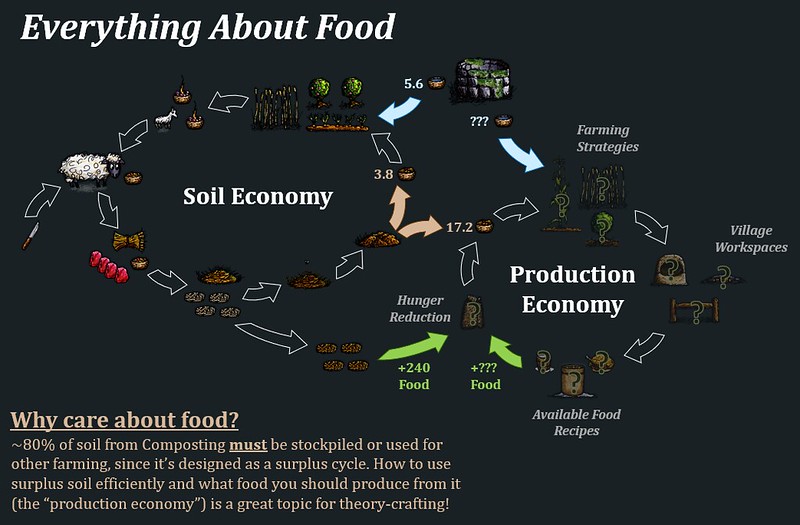
In one sense, it is entirely possible to survive on Mutton Pies alone while your village simply piles up ~80% of its soil in a corner never to be used. This often happens in ancient ruins, where the sheer volume of food that past generations created dwarfs the small number of current inhabitants. At that point, survival simply stops being a significant gameplay element for a few generations.
For every other camp, village, and city you can find, generating a large enough food economy to feed your entire settlement is a difficult, time-consuming challenge. While the soil economy remains critical, it's both (1) Vulnerable to coordination failures at multiple steps and (2) Quite slow to recover, with up to 15 minutes needed to restart it whenever a berry famine occurs. With everyone’s survival on the line, it's a risky gambit to rely on just ~20% of the available food economy to keep everyone fed!
So the obvious choice (and a consistently well-rewarded one) is to build out a diverse food economy and attempt to produce as much food as you can from the ~80% surplus soil available in each Compost cycle.
2. Finding efficient farming strategies
The first approach we'll consider for optimizing food is to determine how much food can you get from each important resource (soil, water, or iron) before they run out. Every resource comes at a cost of player time and effort, so what gives the best possible payoff in a production economy?
Fortunately, OHOL offers an enormous number of alternatives compared to most games for how you can obtain those resources, plant and grow each crop, then convert the harvest into final foods. This presents an enormous challenge for theorycrafting, though, and players can (and often do) spend entire threads just talking about how to optimize one food made from one crop without ever coming to the same results.
So instead of telling you about food efficiency, I’d like to show you!
One Hour One Life - Everything Food Efficiency Plotter
This efficiency plotter covers all the foods currently in OHOL, along with all the possible farming methods you could use to produce them. I encourage everyone to play around with it, since the goal is to help you quickly visualize all the different performance levels without doing a lick of extra math!
Now as you might notice after exploring it for a few minutes, the amount of food that villages can produce for each unit of soil, water, and iron changes dramatically depending on how exactly they plan to plant and grow it. And as you might expect, there's no single-best farming method that optimizes for every resource at the same time.
So lengthy threads about which farming strategies to chase, in order to optimize this or that resource, are sure to continue for a very long time. Should it be soil to reduce famines? Or water to reduce early farming pressure? Or iron to make cities last as long as possible?
Whatever your side, I can offer a few tips based on these efficiency plots:
If you’re aiming for the most Food per Soil, you should be permissive about 2 x Tilling with Steel Hoes or focus heavily on crops that always leave Hardened Rows (such as Corn, Beans, etc.)
If you’re aiming for the most Food per Water, planting close to water sources and upgrading them along the technology tree will probably pay off quicker than trying to conserve usage
If you’re aiming for the most Food per Iron, relying on Stone Hoes is dramatically (often more than 10 - 100x) better than any use of Steel Hoes. Bringing in soil with a Horse Cart is also a great solution to any temporary shortfalls in Iron supply
3. Maximizing food output from village workspaces
A second approach to food optimization (and my personal favorite) is to treat any settlement more like a collection of workshops. Given how much workspace you have in each, how quickly can you produce food in the time your players have available for cooking?
In contrast to farming activities, which tend to meander comfortably around the outskirts of settlements, cooking requires a ton of free space, a variety of different tools and ingredients, and often-frantic activity inside buildings or other crowded spaces near the center of town. It’s entirely reasonable under some circumstances to worry about whether they can cook all the food your growing village needs. If a berry famine strikes, can your workspaces handle the rush of hungry people battering down their doors?
That's a pretty difficult question. Trying to precisely simulate how this could play out in any settlement is messy enough to make a mathematician spit milk out of their nose, and I suspect it wouldn’t be all that helpful for us to look at every possible village arrangement and cooking strategy.
So instead, we'll simplify! If you boil down the essence of each cooking sequence, I think we can pick out 5 major factors that have the largest influence on workspace production:
Food Output - How much food you receive from each batch
Difficulty - How many distinct ingredients, number of steps, or player actions you need to make it
Prep Time - How long in game time you have to wait to grow and cook the ingredients with full player attention
Marginal Gain - Does cooking result in more efficient soil, water, and iron usage than the default diet (munching Gooseberries)?
Diminishing Returns - Does continuing down a longer recipe chain (or with more difficult steps) pay off well?
Based on those factors, I've put together a complete Food Tier List for you that captures (to a rough approximation) how quickly each recipe can produce food and what workspace conditions you should meet before starting it: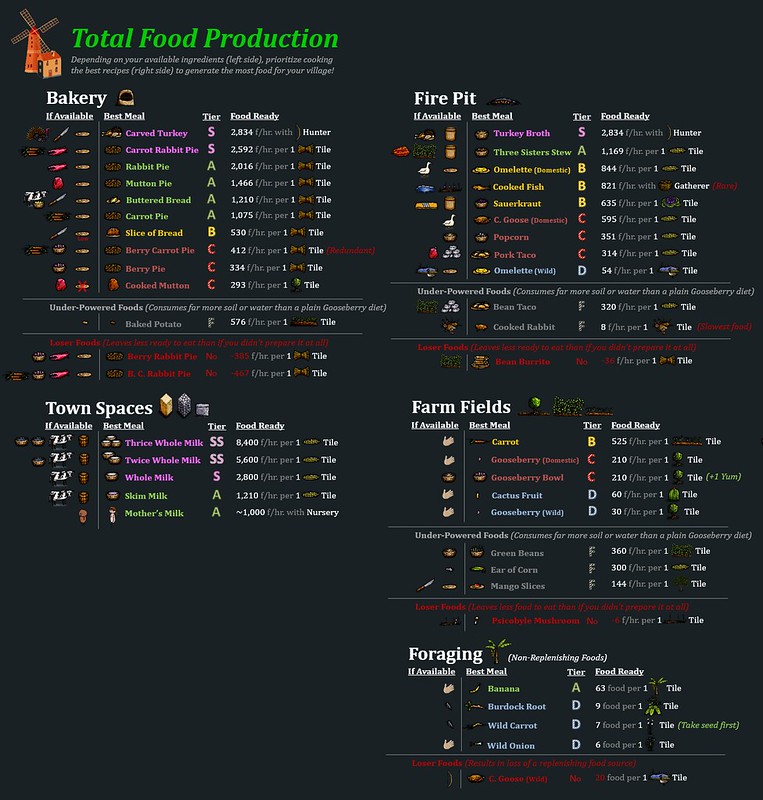
Cautionary Note: As with any attempt at ranking stuff, there's some subjectivity and wiggle room in the grading. I'd like to present these more as friendly suggestions for how to maximize your time and effort in each workspace, rather than a casus belli for murdering new players if they don't happen to follow it. It's also worth sharing with us any tidbits that you think make specific foods better, or worse, than their numbers would suggest!
Each of the Food Tiers represent recipes that have largely similar performance across the factors we mentioned earlier:
SS foods - Ridiculously good, with food production soaring past 5,000 food per hour (f/hr.). Each farming plot you put toward these is equivalent to planting 30 - 50 Gooseberry Bushes.
S foods - A balanced ideal, providing a quick solution to any berry famine with ~2,500 f/hr., but often requiring you to meet complex conditions first. Since they're also up to ~15x better Food per Soil than Gooseberry Bushes, it's always worth going out of your way to prepare them.
A foods - Provide a solid staple diet for any settlement. With ~1,000 f/hr. production it's necessary to devote multiple farm plots to each ingredient to ensure a steady food supply, but the efficiency is much better than Gooseberries.
B foods - Work-intensive for their payoff of ~500 f/hr. The recipes are difficult enough that it will mostly be experienced players handling them, but they're a reliable stopgap if famine strikes.
C foods - Struggle with low production rates of ~200 - 300 f./hr, so they require enormous amounts of farmland to feed a settlement. Other than Gooseberries themselves, most are ~2x as efficient as letting players snack on bushes.
D foods - While forageables can be amazing for efficiency, at ~60 f./hr (or no regrowth at all) you can't use them to support a village. However, they're always a popular snack for experienced players away from town.
Each of the foods and its ranking are available in the efficiency plotter if you’re interested in taking a closer look at how they measure up from a different perspective.
4. Advancing along the food technology tree
A third approach to food optimization aligns more closely with thinking about overall technology advancements. As additional crafting steps become available, what recipes are worth switching to given the ingredients you already have on-hand? And when is it worth pausing cooking to push an infrastructure activity (like Building, Platesmithing, or Smithing) instead?
As players become more experienced across a variety of key professions, this becomes a significant aspect of planning out how to best use your available playtime each life. If the village's resources run out or a berry famine strikes before you've made important technology steps, it can also have deadly consequences for children and new players in your lineage.
Luckily, step-wise food production is relatively simple to optimize because the technology tree for every settlement is exactly the same. Once you know how the foods and their technology requirements are related, the choice between whether to cook or tech up comes easily: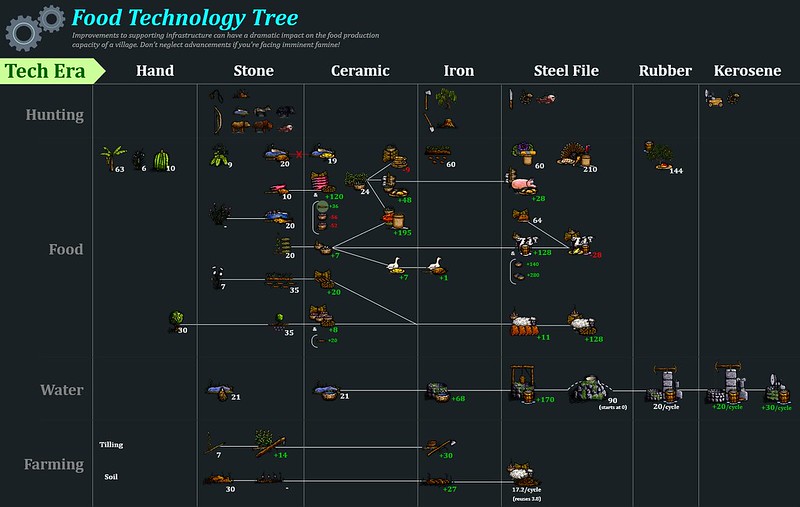
You might notice that several recipes have “negative food” values. This indicates that the pip value of the food actually decreased because you unlocked the recipe or used it. This creates a very challenging situation for players, because we tend to assume that cooking always produces food!
While there are some circumstances that can make these foods worthwhile (for example, teaching children to drink Skim Milk), it puts a serious dent in any consideration of their production rates and soil, water, or iron efficiency. Ideally, these foods will be reviewed by Jason for potential fixes / improvements at some point.
Until then, most of these have been isolated as 'Loser Foods' in the Food Tier List so you can spot them as potential pitfalls. It's entirely up to your judgment (and curiosity) for whether you'd like to try crafting them anyways, but do be careful of anyone who comes near you with a knife!
5. Taking advantage of hunger reduction
The fourth, and final, approach to food optimization is considering mechanics which can reduce how much players need to eat rather than attempting to boost food output or efficiency. Surprisingly, it’s an approach that also tends to be self-defeating: most methods of reducing hunger also boost fertility, so villages which manage to keep hunger low will invariably have more babies and a rapidly-growing population to eat up the difference!
While that often sparks heated discussions of whether hunger reduction has merit for villages, the choice on whether to pursue it depends entirely on personal game mechanics that players (once they're no longer babies) largely have to manage for themselves. Given that, we'll sidestep all of the "greater good" questions surrounding hunger reduction to simply consider whether it has worthwhile personal benefits if you optimize it.
Yum Chaining
At this point you might be curious, “Why wasn’t Yum mentioned way earlier?” That’s largely because Yum Chaining is a function of player history and not the foods you consume. While we can discuss food sets (such as “6 different foods”), the game doesn't concern itself with which ones they are or what order you ate them in order to obtain your Yum bonus.
While it takes a great deal of food knowledge to reach Perfect Yum Chains (which can be anywhere from 12x – 29x), doing so provides around a 40 – 60% reduction in your Total Food per Life requirement. If you succeed, it pays off spectacularly in your later years when you can switch from eating at ~90 second intervals (no Yum Chain) to comfortable stretches of 5 – 6 minutes between meals that can even hyper-extend to 13 minutes at ideal temperatures (fully-clothed near a fire).
The most difficult part, in practice, is becoming familiar with the pip values and starting ages when you can move up to better foods. Any interruptions or overeating can drop you to only modest benefits from Yum Chaining, so it's a bit of a gamble even if you take it seriously.
But if you're the gambling type, then this is for you: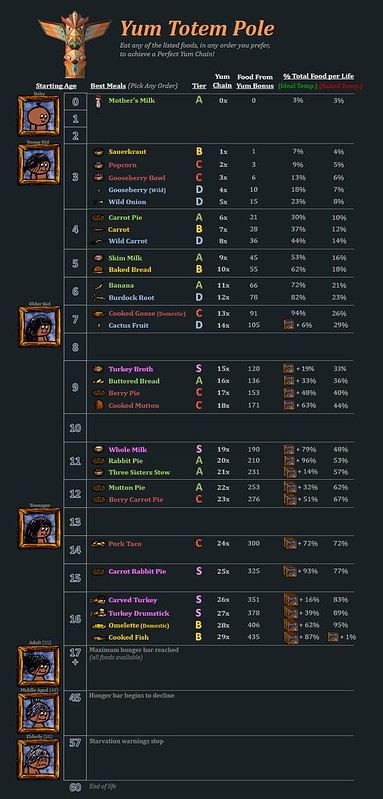
Despite the earlier assurance that we'd sidestep "greater good" questions, it's worth noting that Perfect Yum Chains are entirely possible without resorting to any foods that are less efficient than Gooseberry snacking. That means your overall diet, even with a partial Yum Chain, is going to be quite a bit better than any new player in the village. So this receives a thumbs-up for efficiency!
It’s entirely up to you on whether to pursue Yum Chaining, though. Since it's a personal game mechanic, it's quite hard to notice whether any one player relies on it or not in the overall food economy.
Temperature Management
After Gooseberry tending, temperature management is one of the very first things that most new players learn about in OHOL. While this has seen some major alterations in recent patches, it remains a potent method of hunger reduction for players of all experience levels.
Past work by temperature theorycrafters, suggests that reaching ideal temperatures can bring your Total Food per Life requirement down by as much as 80% over a lifetime. Conversely, mismanaging temperature (such as hanging out in Desert fully-clothed or hugging Mosquitos) can also bring it down greatly by turning you into a toasty pile of bones.
Since temperature management pays off immediately and consistently, it's worth paying close attention to it even if you're not the gambling type. Under the current ruleset, the tips for temperature management are pretty simple:
Clothing - Most types provide high % Insulation, which is indispensable now. Load up with as much as you can wear! Aprons provide no insulation, so it's a tradeoff for extra carrying space.
Fires - When young (baby) or elderly, hanging out ~0-1 tiles from a fire achieves the best temperatures. Natural tiles can no longer bring you to ideal temperatures (like pre-patch Jungle or Desert edges).
Overheating - Avoid spending any substantial time in Jungles or Deserts. They're currently inhospitable enough that only highly-experienced players should pursue activities there (like Oil Drilling).
Although players can only manage temperatures for themselves, it's worthwhile to teach babies and new players about it whenever there's an opportunity. This can improve survival rates for children dramatically, even though there aren't any "neat tricks" for experienced players to master at the moment.
That’s all the topics for this guide! I’m looking forward to discussing it with everyone.
End
Edit: Corrected Carrots to B rank in graphics
Last edited by Ferna (2019-03-24 02:00:14)
Offline
#2 2019-03-23 18:57:05
- futurebird
- Member

- Registered: 2019-02-20
- Posts: 1,553
Re: Everything About Food (Theorycrafting Guide)
This is so cool. I quibble about the stone hoe, though. It's possible to send people foraging for steaks and use those to save the string for... well for everything.
---
omnem cibum costis
tantum baca, non facies opus
Offline
#3 2019-03-23 19:07:29
- Booklat1
- Member
- Registered: 2018-07-21
- Posts: 1,062
Re: Everything About Food (Theorycrafting Guide)
First, excellent topic, specially because we don't usually see time being accounted for and your food techtree is neat.
Did your list in 4 consider tilling or shovel usage? I think this could hurt berries and mangos, since they have no continuous tilling cost as their major advantage.
Carrots shouldnt score so much better than berries overall just because of production speed (i mix both early game because of speed + stability).
Offline
#4 2019-03-23 21:08:10
- fragilityh14
- Member
- Registered: 2018-03-21
- Posts: 556
Re: Everything About Food (Theorycrafting Guide)
this is extremely impressive. If you don't mind my asking, how long did it take and what do you do for a living?
I'll tell you what I tell all my children: Make basket, always carry food.
Listen to your mom!
Offline
#5 2019-03-23 22:59:25
- Ferna
- Member
- Registered: 2019-02-01
- Posts: 28
Re: Everything About Food (Theorycrafting Guide)
This is so cool. I quibble about the stone hoe, though. It's possible to send people foraging for steaks and use those to save the string for... well for everything.
The farming strategies for Stone Hoe assume that you grow the 4 Milkweed domestically so you won't eventually deplete all availability for it. With that approach, planting with 1 Soil x 2 Tilling turns out to be the cheapest per Tilling use. Domestic Saplings are left out since they produce the Weak Skewer variant that breaks instantly if you try to Till with it (no net Tilling uses).
Foraging is basically free from an efficiency perspective, so any Skewers or Milkweed you gather from the wild will match Steel Hoes for Food per Soil and Water per Soil, but have ~30% better Food per Iron than (domestic) Stone Hoes in the same situation: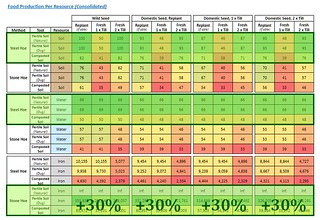
While villages don't grow Milkweed often now, if we're keen on maximizing Iron efficiency perhaps we should consider it as a large-scale practice? It would certainly transform the Rope availability for other tech if we did! (Bows, Buckets, Hand Carts, ...)
Offline
#6 2019-03-23 23:08:09
- GreatShawn
- Member
- Registered: 2018-09-08
- Posts: 381
Re: Everything About Food (Theorycrafting Guide)
In the end, water and iron are the ultimate roots of civilization.
Offline
#7 2019-03-24 00:43:56
- Spoonwood
- Member
- Registered: 2019-02-06
- Posts: 4,384
Re: Everything About Food (Theorycrafting Guide)
This is so cool. I quibble about the stone hoe, though. It's possible to send people foraging for steaks and use those to save the string for... well for everything.
The biggest problem with stone hoes lies in that people don't grow the milkweed after using it. If people grew 4 milkweed everytime they made a stone hoe, there would exist a lot less suspicion about people making them.
Danish Clinch.
Longtime tutorial player.
Offline
#8 2019-03-24 01:44:13
- Ferna
- Member
- Registered: 2019-02-01
- Posts: 28
Re: Everything About Food (Theorycrafting Guide)
Did your list in 4 consider tilling or shovel usage? I think this could hurt berries and mangos, since they have no continuous tilling cost as their major advantage.
Every food on the list (other than Compost cycle crops) is required to use soil, water, and iron more efficiently than a Gooseberry diet under the best farming strategy for that resource, which turns out to be a pretty reasonable standard with most foods. Generally, there's no single-best farming strategy that delivers the top efficiency on every one of those resources at once though.
Mango Slices are marked as an 'Underpowered Food' since they don't meet the standard on water usage compared to Gooseberry Bushes (even regrowth is an ~60% drop in Food per Water). They also take at least 2.5 hours to start producing just 144 f/hr., so there's currently not much incentive to grow them for survival purposes.
If you're still curious, you can look at all the comparisons for yourself on this section of the efficiency plotter: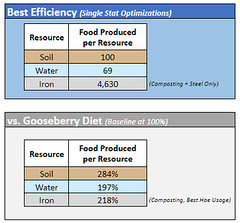
Carrots shouldnt score so much better than berries overall just because of production speed (i mix both early game because of speed + stability).
It looks like they snuck into the graphics with a different rating than intended! (will be fixed shortly)
Carrots are just a little higher (B food) than Gooseberries (C food) since they have similar efficiency, but you can start churning out ~525 f/hr. in as quickly as 4 minutes when there's a berry famine. It's enough of a stopgap food supply to save a lot of children from starving, but too work-intensive to provide a staple diet for the entire village.
Offline
#9 2019-03-24 02:55:55
- BlueDiamondAvatar
- Member

- Registered: 2018-11-19
- Posts: 322
Re: Everything About Food (Theorycrafting Guide)
Mango Slices are marked as an 'Underpowered Food' since they don't meet the standard on water usage compared to Gooseberry Bushes (even regrowth is an ~60% drop in Food per Water). They also take at least 2.5 hours to start producing just 144 f/hr., so there's currently not much incentive to grow them for survival purposes.
Thank you Ferna! for pushing me over the edge into the depths of my hatred for mangos. I very much enjoyed chopping down five out of the ten mango trees growing in "Cletown" today.
They are worse than berries! And have no redeeming qualities for feeding sheep!
But worse than that... With ten trees producing five mangos a cycle, they can easily clutter up all available cooking space in even our largest cities.
What really put me over the edge into my mango-hating obsession, was seeing the Cletown bakery filled to the brim with plates of sliced mango, while no one bothered with carrots and wheat for a while. Sliced mango is a super inconvenient food, that can't be stored in a backpack or a basket, and takes up both plate and preparation space that would be better used for mutton pies (for example).
That may be the only aspect missing from your analysis - a convenience factor, which I see as a combination of storage compactness and the ease of transportation. It might also be interesting to calculate the minimum dedicated tilespace necessary for preparing each of these foods. Bananas? zero tiles required. Rabbit Pie? fifteen tiles by my count.
--Blue Diamond
I aim to leave behind a world that is easier for people to live in that it was before I got there.
Offline
#10 2019-03-24 06:27:12
- pein
- Member

- Registered: 2018-03-31
- Posts: 4,337
Re: Everything About Food (Theorycrafting Guide)
just some notes:
you can already farm making a pouch which only requires snare and fire tools, but no kiln
so even if you are nomad who plants some carrots while hunting down savannas it's enough
generally soil hauling is still better than double tilling, i cant see this any other way than disrespect towards others
make a compost and use double soil, don't be a lazy fuck
especially hate those who unstack soil after i stack for them
plate usage is also a good factor
while eggs are okayish, i mainly don't like them cause they take up a plate
while goose doesn't, so if you put the gooses in cart you can use 2 stumps to decap them, then clean them up
you don't have to cook it right away, it's definitely viable if you got a pen for them
bread is main food because hats and baskets are always good, and using up your excess is often the cheapest way to make food
https://onehouronelife.com/forums/viewtopic.php?id=7986 livestock pens 4.0
https://onehouronelife.com/forums/viewtopic.php?id=4411 maxi guide
Playing OHOL optimally is like cosplaying a cactus: stand still and don't waste the water.
Offline
#11 2019-03-24 11:59:38
- breezeknight
- Member

- Registered: 2018-04-02
- Posts: 813
Re: Everything About Food (Theorycrafting Guide)
amazing ![]()
i have though a problem with the color code
SS foods & C foods
are at the opposite ends of the usefulness spectrum but their color is too similar
use rather the street light code
red for a nono
green for a good to go
yellow for average
or gray for average
- - -
Last edited by breezeknight (2019-03-24 12:05:18)
Offline
#12 2019-03-24 21:10:53
- Anandamide
- Member

- Registered: 2018-06-05
- Posts: 142
Re: Everything About Food (Theorycrafting Guide)
Wow this is everything
Offline
#13 2019-03-25 00:05:53
- antking:]#
- Member

- Registered: 2018-12-29
- Posts: 579
Re: Everything About Food (Theorycrafting Guide)
how did you manage to make all of this? this is what I would call dedication!
"hear how the wind begins to whisper, but now it screams at me" said ashe
"I remember it from a Life I never Lived" said Peaches
"Now Chad don't invest in Asian markets" said Chad's Mom
Herry the man who cheated death
Offline
#14 2019-03-27 01:28:14
- betame
- Member
- Registered: 2018-08-04
- Posts: 202
Re: Everything About Food (Theorycrafting Guide)
Again, I’m impressed by this work. Its very thorough and displayed nicely.
That said, I think I caught a few small mistakes in the efficiency plotter:
It looks like carrot should have no D. Seed replant, while cabbage should. (From my understanding, ‘replant’ means using the hardened row or bush left after harvest?) On the same vein, it seems like most compound foods (except wheat-only foods) should have a replant strategy.
Also for compound foods, it looks like the seed cost if off. I get that you’re counting the entire batch as one all-inclusive seed, but you missed a -1 on their food stats page then. For example:
carrot S7 = F13/F16
carrot pie s7 = F13/1
carrot pie F13 = 4/5*Z15/$AC15+1/1*Z14/$AC14 from the food stats page
Should be 4/5*Z15/($AC15-1)+1/1*Z14/$AC14
The rest has to do with the Compost Cycle page, and only has a tiny effect on the soil, water, and iron used.
E35 counts 4 carrots instead of 2:
,(2*2/5*’Compost Cycle'!$E$27+
E23 and F23 also are missing the -1 for seeds:
Should be replant cost + seedResources/(numSeed-1)
The “replant” compost strategy only differs in that it uses wild seed, and the “fresh” strategies already assume replanting.
I’m confused why you allow all the compost strategies to iterate using the “replant/wild seed” soil efficiency
*( 1 / ( 1 - MIN( 'Efficiency Plotter (Main)'!$AF15:$AH15 ) )
I’m also confused why the soil cost multiplier isn’t
*(1+'Efficiency Plotter (Main)’!$AH15 )found where the similarity is in our aproaches; 1/(1-x) = 1+ [x/(1-x)] for x=/=1
1 - %eff =3.18/17.82 = 1/(1-(3.18/21)) - 1
Because ‘Efficiency Plotter (Main)’!$AH15 to me means the extra soil needed for compost per soil
I’m basically confused by the iteration and multiplier strategy in general;
I’m used to treating compost as a water and iron-only cost:
4.18 water + .0244 shovel + 2.53 till = 17.82 soil
So I’d treat 2xT bread on the main page to cost 1 soil in all cases.
if composting, the soil remains 1 but the water becomes 2 + 1*4.18/17.82)))
All in all, its neat to see a different viewpoint and I could use some help understanding the way you model compost
What are your thoughts on displaying the the mutton pie food and skin bonus with the compost strategy?
Maybe also the byproducts straw/dung from wheat products/cooked mutton?
Last edited by betame (2019-03-30 10:51:11)
Morality is the interpretation of what is best for the well-being of humankind.
List of Guides | Resources per Food | Yum? | Temperature | Crafting Info: https://onetech.info
Offline
#15 2019-03-28 11:10:04
- Ferna
- Member
- Registered: 2019-02-01
- Posts: 28
Re: Everything About Food (Theorycrafting Guide)
I've finished making some big updates to the Efficiency Plotter based on everyone's suggestions so far!
Forage tactics for farming tools now have their own strategy section (includes both Skewers and Stone Hoes from wild Milkweed)
Numerous fixes for seed costs, compost cycle, and Potato formulas (thanks Betame!)
Took out a shortcut in the compost math to make it more precise
Added Ice Cream to the food options for the upcoming release
Older versions of each sheet are still available and renamed to "(1.0)" for anyone who wants to compare the changes.
Offline
#16 2019-03-28 12:06:09
- Ferna
- Member
- Registered: 2019-02-01
- Posts: 28
Re: Everything About Food (Theorycrafting Guide)
Now, for the neat theorycrafting stuff!
On the same vein, it seems like most compound foods (except wheat-only foods) should have a replant strategy.
For foods where only a few of the ingredients can be replanted, the efficiency plots use the best choice between replanting or 1XT / 2XT for each crop. In practice, that basically assumes you'll replant any crop that can be (since it's always better).
All in all, its neat to see a different viewpoint and I could use some help understanding the way you model compost.
This approach to modeling Compost uses the real-world math for manufacturing productivity, so you can basically describe it as a comparison between the production effort vs. useful results we receive from each complete cycle through the soil economy. Since that number is below 100%, it means that a Basket of Soil taken from a Compost Pile actually represents less food than an identical Basket of Soil taken from a Fertile Soil Pit when planting the same crops. In each case, this difference should be exactly 1/7th of the useful soil that was lost in creating that Compost Pile.
However, figuring out that 'exact' lost amount could actually be a really long and messy calculation:
If we assume a rounded 20% of the soil in each Compost Pile is lost on creating the next one, then whenever a player collects a Basket of Soil from it we effectively lose 0.6 Fertile Soil in food potential
But... when that 0.6 Fertile Soil was taken from some Compost Pile, we lost another 0.12 Fertile Soil in food potential
And when we took that from some Compost Pile, we lost another 0.024 Fertile Soil in food potential
And when we took it again, another 0.0048 Fertile Soil in food potential
And again, another 0.00096 Fertile Soil in food potential
And again...
So exactly how much Fertile Soil did we lose on the way to that 1 Basket of Soil? You could keep counting up to an infinite number of ever-smaller soil piles if you had enough patience! Luckily, the math for doing that is actually sillypants easy:
That's where the soil cost multiplier comes from, since it's using this as a shortcut calculation for "How much Fertile Soil was lost if all the soil came from Compost?" Basically an extended version of what you suggested.
The iterations for the Compost Cycle spreadsheet follow essentially the same math, but breaking it into stages: "How much is lost if it all came from 1st generation Compost Piles?" "What about 2nd generation?" "...3rd generation?" "...4th generation?" "...1,000th generation?" What we find is that within a few generations, the answers level out to effectively the same soil efficiency no matter how far out you go.
Here's how that process looks, from a new tab I added to the efficiency plotter (called Compost Progress):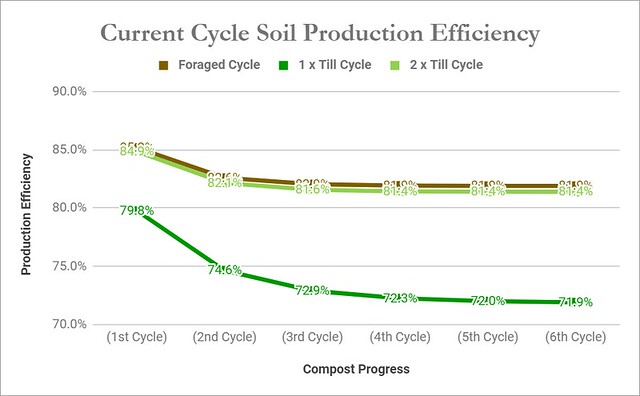
Where all this becomes important is the productivity penalty that it places on every subsequent stage of farming and food-making. When you carry 100 Baskets of Soil from the Compost Pile over to growing areas, 20 - 30 of them will produce no food for the settlement. Each minute spent tilling and farming that soil produces no food. Each person busy with processing it produces no food. Each Hoe you craft for it produces no food. (I'm over-simplifying a little bit here for rhetorical effect)
If we convert all that into an efficiency cost for food production, we get the Compost strategies shown on the plotter along with what (should be) the real food productivity that players experience when relying entirely on the Compost cycle.
What are your thoughts on displaying the the mutton pie food and skin bonus with the compost strategy?
Maybe also the byproducts straw/dung from wheat products/cooked mutton?
From an efficiency perspective, the Mutton Pie and Wool/Sheepskin production is actually the same everywhere. That's why it's left out in the calculations. As long as you use 100% of the surplus soil from each Compost cycle, anything you grow (even non-food) will give an extra 240 Food and 1 Wool/Sheepskin.
The one exception is Mutton Pie itself, since it can't be produced without (technically) starting a new Compost cycle. The efficiency calculations for it basically assume that you've thrown out all the soil from its cycle, generally by allowing Sheep Dung to pile up near the sheep pen that never gets used in your generation.
If the cycle gets completed eventually, that Mutton Pie becomes part of the "soil economy" and doesn't affect the ~17.2 surplus soil we're trying to optimize for food production anymore. The same exclusion also probably applies for any of the 'free' outputs you might decide to make:
Mutton Pie (+240 Food)
Cooked Mutton / Baked Bread (+112 Food)
Cooked Mutton / Rabbit Pie (+272 Food)
Cooked Mutton / Wild Bean Burrito (+162 Food)
But this might even be worth its own discussion if we're breaking open the possibility for alternative Compost cycles.
Offline
#17 2019-03-31 02:50:56
- betame
- Member
- Registered: 2018-08-04
- Posts: 202
Re: Everything About Food (Theorycrafting Guide)
We could move the compost talk to another thread if you want, but I think I've found a way to show what I mean.
I created a page in the plotter called "Copy of Compost Cycle (became exploring)"
I've laid out a few possible ways to iterate (in addition to solving directly) and find the multiplier that accounts for compost soil cost per crop soil
I think the issue was that you'd applied the compost efficiency to crop efficiency;
It's hard for me to wrap my head around but I think the multiplier you iterated for meant:
for each basket of soil *ratio* goes to compost AND *same ratio* of the crops is lost upon harvest

I think we agree that the iterations should illustrate the left side of the equation, and the useful result should be the right side
Last edited by betame (2019-03-31 11:10:14)
Morality is the interpretation of what is best for the well-being of humankind.
List of Guides | Resources per Food | Yum? | Temperature | Crafting Info: https://onetech.info
Offline
#18 2019-03-31 04:24:46
- futurebird
- Member

- Registered: 2019-02-20
- Posts: 1,553
Re: Everything About Food (Theorycrafting Guide)
I'm so sad you didn't enjoy my L'Hopital joke....
---
omnem cibum costis
tantum baca, non facies opus
Offline
#19 2019-03-31 14:31:46
- Anandamide
- Member

- Registered: 2018-06-05
- Posts: 142
Re: Everything About Food (Theorycrafting Guide)
I'm so sad you didn't enjoy my L'Hopital joke....
I dont see it in this thread, did you forget to post? Id love a good calculus joke.
Offline
#20 2019-04-01 00:01:31
- Ferna
- Member
- Registered: 2019-02-01
- Posts: 28
Re: Everything About Food (Theorycrafting Guide)
Efficiency Plotter now has complete details on the v213 food additions.
In light of the heated debate around Tilling methods, I also made a few other additions for everyone:
Efficiency plots for 1 x Tilling and 2 x Tilling now assume you use the same method for Compost production, rather than the best available. This should give us the truest picture of what farming productivity looks like if your settlement commits to a single approach for all Farmers (as most proponents of each Tilling method have argued for)
Iron consumption between Tilling methods is now shown on the left, so you can quickly compare it for any food
Compost Cycles are now listed as a recipe, so you can see how any food stacks up against the soil economy
All Compost usage calculations have been tweaked to be more accurate (Water and Iron taxes should scale strictly with Soil usage now)
When everyone has a chance to look through the Tilling comparisons, the results might come as quite a surprise! It turns out that 1 x Tilling only typically saves around 5 - 18% on Iron consumption, with less impact any time additional tools are needed (e.g. Shovel for Compost Cycle, Shears for Tortilla Chips). This is dramatically less than the 50% savings that you might intuitively expect when considering how to plant a single crop, but it comes as a direct consequence of the increased Compost usage when you pick that farming strategy.
Does that change where you stand on the Tilling debate or reinforce your thoughts about which is best?
Offline
#21 2019-05-09 20:27:32
- lychee
- Member
- Registered: 2019-05-08
- Posts: 328
Re: Everything About Food (Theorycrafting Guide)
This is amazing! I love you so much for this!
Offline
#22 2019-05-10 11:39:39
- CatX
- Member
- Registered: 2019-02-11
- Posts: 466
Re: Everything About Food (Theorycrafting Guide)
When everyone has a chance to look through the Tilling comparisons, the results might come as quite a surprise! It turns out that 1 x Tilling only typically saves around 5 - 18% on Iron consumption, with less impact any time additional tools are needed (e.g. Shovel for Compost Cycle, Shears for Tortilla Chips). This is dramatically less than the 50% savings that you might intuitively expect when considering how to plant a single crop, but it comes as a direct consequence of the increased Compost usage when you pick that farming strategy.
Does that change where you stand on the Tilling debate or reinforce your thoughts about which is best?
As long as compost is something that can be produced, while nearby iron runs out eventually, my feeling is that 1xtilling is still better.
Offline
#23 2019-05-10 19:45:58
- DestinyCall
- Member
- Registered: 2018-12-08
- Posts: 4,563
Re: Everything About Food (Theorycrafting Guide)
Ferna wrote:Does that change where you stand on the Tilling debate or reinforce your thoughts about which is best?
As long as compost is something that can be produced, while nearby iron runs out eventually, my feeling is that 1xtilling is still better.
The problem is that there is a distinct labor/time cost to using more soil. Compost production is technically infinite, but it is not really fun and takes a long time to get going again if people neglect the cycle for too long or it gets actively griefed. Plus, the composting process itself costs some iron, so making more compost meaning extra tool uses. By stretching your soil reserves as far as possible, you save time and labor without costing much iron. Assuming you focus on iron-efficient crops, you can farm twice as much while only using 10% more iron. With the time you save on compost production, you could send someone out to gather a few baskets of iron and end up ahead.
It is something to keep in mind, especially if you have a decent iron supply in town to support making a few extra hoes.
Offline
#24 2019-05-10 19:50:22
- Tarr
- Banned

- Registered: 2018-03-31
- Posts: 1,596
Re: Everything About Food (Theorycrafting Guide)
CatX wrote:Ferna wrote:Does that change where you stand on the Tilling debate or reinforce your thoughts about which is best?
As long as compost is something that can be produced, while nearby iron runs out eventually, my feeling is that 1xtilling is still better.
The problem is that there is a distinct labor/time cost to using more soil. Compost production is technically infinite, but it is not really fun and takes a long time to get going again if people neglect the cycle for too long or it gets actively griefed. Plus, the composting process itself costs some iron, so making more compost meaning extra tool uses. By stretching your soil reserves as far as possible, you save time and labor without costing much iron. Assuming you focus on iron-efficient crops, you can farm twice as much while only using 10% more iron. With the time you save on compost production, you could send someone out to gather a few baskets of iron and end up ahead.
It is something to keep in mind, especially if you have a decent iron supply in town to support making a few extra hoes.
Iron in the current game is unlimited if you want to put the work into it. The problem is most people aren't going to put in the extra mile to fetch that iron so it makes sense to be somewhat stingy on its usage.
On the flip side though, most towns aren't going to live to see a potential true iron crisis so either way damned if you want to save iron, damned if you don't.
fug it’s Tarr.
Offline
#25 2019-05-10 20:10:41
- Joseph Stalin
- Member

- From: Москва
- Registered: 2018-04-16
- Posts: 207
Re: Everything About Food (Theorycrafting Guide)
it would be better if Jason just decides one way or the other and makes that the only way to do it
Offline
